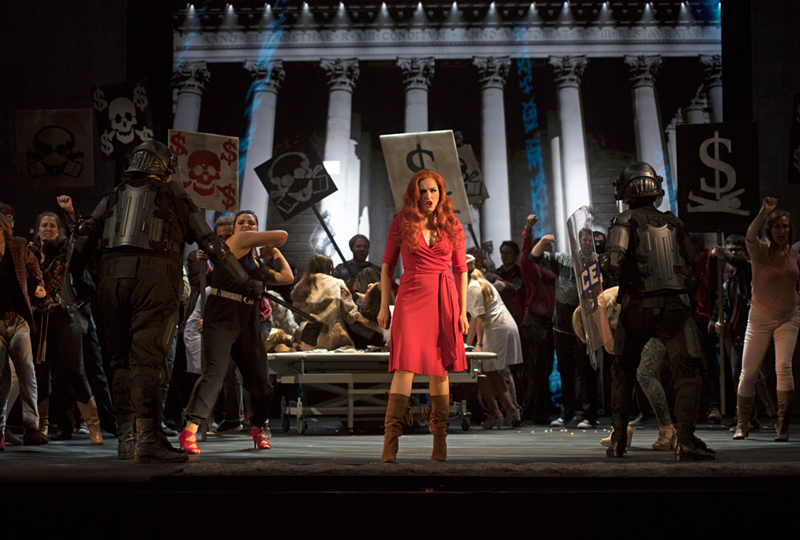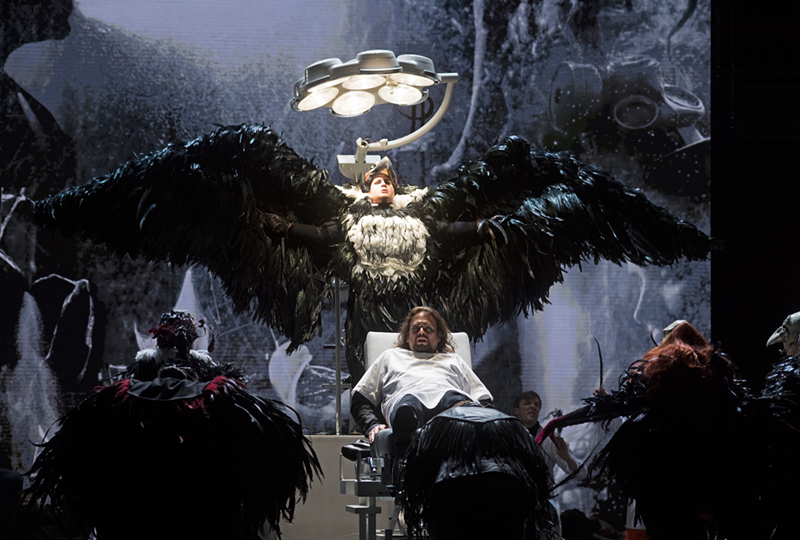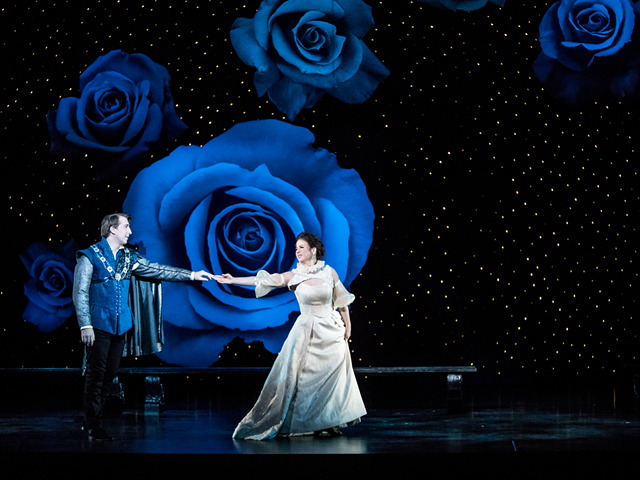CRITIC'S PICK
Cincinnati Opera’s production of Another Brick in the Wall, based on Pink Floyd’s 1979 Rock magnum opus The Wall, is an entertaining and hallucinatory spectacle that explores Rock & Roll excess, mental illness and fascism.
It had its U.S. premiere here Friday evening at Music Hall, in an operatic version composed by Julien Bilodeau using the original words and music of Pink Floyd’s co-founder Roger Waters. Opera Montreal gave Another Brick in the Wall its world premiere last year.
Rather than simply adapt the album into a stage performance, Bilodeau has deconstructed the familiar tunes, stripping the lyrics and melodies to their essences to build something new. This solves a crucial problem: How to render The Wall’s familiar twists and climaxes in a surprising way?
This isn’t a Rock opera. Vocals are unamplified; guitars only appear as visual props. And throughout, the audience is treated to mind-bending visuals, an outstanding chorus and lighting, stage design and choreography of the highest caliber.
Like the album, the opera struggles to find coherence in its first act. This is a problem built into the story itself: A Rock star crumples under the weight of his own manic grandeur, embodied by a literal and metaphorical wall. We see and hear everything through the eyes and voice of the unraveling star, Pink (Nathan Keoughan). As the story ramps through disorienting heights of Rock & Roll indulgence, the spectacle feels deflated and its star seems bored and disengaged. It’s hard to tell if this was a deliberate choice or the result of the bass-baritone lacking stage presence.
While other characters are allotted some depth, they remain the projections of a supreme megalomaniac’s disordered mind. Pink often stands to the side, a stoned observer, while France Bellemare (The Mother) and Caroline Bleau (The Wife) carry the show with stellar vocal and dramatic performances.
When the story dives into incoherence, the set plays a prominent role in keeping the production exciting. Johnny Ranger’s video design, shown on a central LED screen and projected onto flanking walls that move around the stage, is exquisite and hypnotic, if occasionally overwrought. The projections were most effective as abstraction but sometimes fell flat when depicting recognizable imagery, such as when shaky stock footage of people partying renders Pink’s hedonism generic.
Although there are some missteps in the first act, the darkly spectacular second act more than makes up for it. The opera’s much stronger second act opens with young Pink before the curtain, setting up rows of white crosses. The curtain rises to an adult Pink, strung out, shadows playing on the wall. Keoughan’s powerful vocals at last fall into place, and Ranger’s video design hits its mark and adds depth to Pink’s inner anguish.
Under the baton of Alain Trudel, the Cincinnati Symphony Orchestra and Bilodeau’s orchestration shine brilliantly. Every bit as divergent from the original album version as the Scissor Sisters’ 2004 Disco rendition, the familiar lyrics and melodies of “Comfortably Numb” are deconstructed amid eerie woodwinds as Bellemare’s Mother breathlessly sings to a convalescing young Pink. On the Pink Floyd album, the song is propelled by David Gilmour’s guitar solo like a spaceship sling-shotting around a star. Here, the gravitational center is removed, and it is easily among the production’s most stunning transformations.
The opera’s final crescendo wholly immerses the audience in Pink’s madness, which has devolved into a full-blown fascist fantasy. The massive chorus and cast of extras writhe and clamor from every surface, giving way to the climatic trial scene.
Two aspects are especially noteworthy: Costume designer Marie-Chantale Vaillancourt must have tapped into some kind of Hieronymus Bosch hellscape dimension to devise the bird creatures populating the stage. And James Eder’s performance as The Judge is fiendishly inspired. Wheeled out in a hallucinatory blend of demon blackbirds and surgical light, he bellows his judgment as a trembling, cowering Pink says, “They must have taken my marbles away!”
In spite of its flaws, Another Brick in the Wall is an entertaining and cathartic trip that Pink Floyd and modern opera fans alike will find compelling. The Cincinnati Opera has done an outstanding job realizing this ambitious project.
Another Brick in the Wall has performances 7:30 p.m. Thursday (July 26), Saturday (July 28) and Tuesday (July 31) at Music Hall. Tickets: cincinnatiopera.org.







